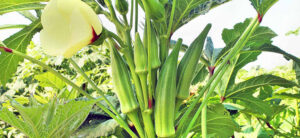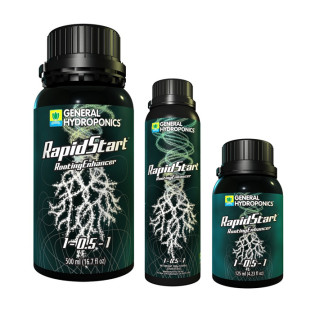
Learning how to grow okra from seed to harvest is an inevitability if you're a southern gardener, as there’s little doubt that this plant is a staple in your region and culutre.
However, northern growers often forget that it’s possible to grow this tasty vegetable in hardiness zones as cold as zone 6.
Although it thrives in warm weather, it’s certainly not out of the realm of possibility for gardeners all over the country to cultivate it.
And, when you follow our tips on how to grow okra from seed indoors before moving it outside, you can get a jump on the garden season and ensure a delicious, bountiful harvest in any climate.
If you're a first time grower considering adding this veggie to your raised garden bed, or perhaps growing it in containers, you've come to the right place.
We'll teach you everything you need to know to get your seeds popped and your okra blooming - including what you need to get started, when to plant okra, pests/diseases to watch for, along with the rest of the essential info on getting this veggie onto your dinner plate.
Let's start with some basic gardening information on this plant - including conditions it likes, how easy it is to grow, and more.
What Is Okra?
Often referred to as “lady’s fingers,” okra is a vegetable that has a long, slender shape and can be eaten in hundreds of ways.
Whether you prefer it raw, pickled, sauteed, or stir-fried, okra has plenty to offer any cook. Traditionally grown in the south, okra is easy to cook and easy to care for in the garden.

It also adds a nice flowering aesthetic to your garden during the growing season, as it has beautiful flowers.
Rich in nutrients, this plant grows best in slightly acidic to neutral soils. There are several varieties of okra you can grow, including:
- ‘Louisiana Green Velvet’
- ‘Cajun Delight’
- ‘Blondy’
- ‘Clemson Spineless’
- ‘Park’s Candelabra Branching’
- ‘Annie Oakley II’
Is Okra Easy To Grow?
Okra is easy to grow as long as you follow the tips detailed in this article. It has a misconception as being a challenging vegetable to cultivate, but that mostly has to do with the difficulty some growers experience in getting the seeds to germinate.
That’s because these weeds have a hard coat that can slow down germination. To speed it up, soak the seeds overnight in warm water or use a rooting hormone to encourage germination.
This only needs to be done once, the night before you plant. This should help soften the coating and make it easier for your plants to emerge.
How Long Does It Take For Okra To Grow?
Okra reaches maturity in 50 to 65 days after seeds have sprouted. They will then produce pods for up to 12 weeks, depending on the length of your growing season and health of your plants.
Of course, this is just an estimation. How long it will take your okra to grow will depend on the weather, nutrient and soil quality, and an abundance of other factors - some in your control, some not.
Does Okra Grow Back Every Year?
Grown as an annual in most places, okra is actually a perennial plant in its native growing zones. If these classifications are foreign to you, we encourage you to read our complete guide on annuals vs perennials.
It is native to dry, tropical regions, so if you’re lucky enough to live in one of these locales, you can actually enjoy okra that produces a tasty harvest for you year after year.
What Do You Need To Grow Okra?
Okra needs very little aside from the basic garden essentials - soil & containers, sunlight (or grow lights if you have a greenhouse or indoor garden), and water/nutrients.
You will also need some starter plugs if you plan on starting seeds indoors. If this is the approach you're going to take, we highly encourage you to just invest in a complete seed starting kit. These will have you germinating seeds efficiently, including everything you need to get seeds popped.
Other than that, all you need is a sunny location in your garden with fertile, loamy soil. You'll need to add some fertilizer or plant nutrients later on too.
Can Okra Be Grown In Pots?
If you’re concerned about the length of your growing season or how much garden space you have available, don't worry - okra can also be grown in garden pots or containers.
To do this, you will need to start with a large pot that has a diameter of at least 10-12 inches. One that has a wide bottom is preferred since okra grows so tall so quickly it can become a tipping hazard.
Other than that, make sure the pot has good drainage in the bottom and bring the container indoors when cold weather threatens. Place your container of okra in full sun the rest of the time.
What Is The Best Fertilizer For Okra?
Okra should be fertilized prior to planting with fertilizer. A 10-10-10 or a 15-5-10 is best, spread at a rate of two pounds for every 100 square feet of garden.
You can also use a more natural fertilizer, like compost tea or aged manure, but note that a nitrogen-rich fertilizer is ideal.
How To Grow Okra From Seed To Harvest
Okra is easy to care for - provided that you follow some simple tips at planting time. Here is a step-by-step guide on how to grow okra from seed to harvest.
When Should Okra Be Planted?
Okra is a warm-weather vegetable that is hardy in zones 6 through 11. Although you can start seeds indoors to get a head start on the growing season (something we’ll address below), you will need to take certain precautions because the seedlings can be somewhat fragile and susceptible to frost damage.

If you start seeds indoors, the best time to do so is at least three to four weeks before the last spring frost date.
You can also start seeds in the garden at this time, but you’ll want to cover the fragile plants with a cold frame or tunnel until the weather warms up (to prevent your plants from freezing).
If you live in a warmer growing zone, you can start the seed when the temperature reaches about 65 to 70 degrees.
That’s soil temperature, not air temperature - so it may be as late as early July by the time the soil is warm enough to plant in.
What Is The Best Way To Plant Okra?
In most cases, the best way to plant okra is to start the seeds directly in the garden. That’s because it can be somewhat finicky when transplanted.
However, if you’re able to sow the first seeds indoors and you don't want to wait till July to get your crop started, this will be your best bet - particularly if you live in a colder growing zone.
By doing this, you can transplant the started seedlings as soon as the weather is warm without having to worry about a shorter growing period. This way, you can still get through harvest season before it gets too cold.
When sowing your seeds, do so about half an inch to one inch deep. Rows should be about three to four feet apart, as the plants will grow quite tall. Within the rows, okra plants should be about 12 to 18 inches apart.
Does Okra Need Lots Of Water & Nutrients?
Before planting, consider testing your soil. For okra, soils should be on the acidic side, with a pH that’s approximately 5.8 to 7.0. Our pH testing supplies are a necessity in any garden. Otherwise, your plants will develop deficiencies.
Full sun is preferable. It can be grown in just about any soil although it does best in those that are well-draining and rich in organic matter like compost.
Caring for okra is relatively easy - this is not a super water- or nutrient-heavy plant.
You can fertilize before planting with aged manure, rich compost, or a 10-10-10 fertilizer, or you can top-dress the plants with organic amendments after the shoots emerge.
This can be done on a monthly basis, ideally with a liquid fertilizer. When your plants are about three inches tall, thin them so they’re growing 12 to 18 inches apart (if that’s not already the case).

Mulch at a depth of two inches to prevent weeds, and eliminate weeds as early in the summer as possible - it can be tricky to do so after your okra plants begin to appear.
Okra Pest & Disease Prevention
There are few diseases that affect okra, but most are caused by poor weather conditions (diseases are more prevalent in cloudy, wet weather).
The most common diseases include verticillium and fusarium wilts. These soil-borne diseases will cause your okra to wilt and die.

To prevent them, follow proper spacing guidelines and always water first thing in the morning, so the plants have time to dry out before nightfall.
Check your plants regularly and use a fungicide if diseases appear, as most diseases are fungal-related. You can use neem oil or sulfur, too.
When it comes to pests, you’ll want to watch out for Japanese beetles, aphids, flea beetles, stink bugs, and corn earworms.
Root-knot nematodes and fire ants are also common. In most cases, these pests can be prevented by making sure your plants are adequately watered and fertilized, as pests are more likely to feast upon weak plants.
However, if they arise, you may need to use controls like neem oil or other pesticides to get rid of these pests on your plants.
Read up on our list of the most common garden pests & diseases so you'll know what to watch for, and can act accordingly in case of an outbreak or infestation.
How To Harvest Okra
Okra can be harvested about two months after planting. You'll know your plants are ready to be cut when they are about two to three inches long.

Once the shoots appear, you can harvest it as frequently as every other day, which will encourage new shoots to appear.
To harvest, simply cut the stem where it rises above the cap. Use a sharp knife, don’t twist or yank. Always be sure to disinfect your tools prior to use.
If the stem seems too hard to be cut, there’s a strong chance that the pod is no longer good. You may also want to wear gloves while you work - okra has tiny spines that can irritate your skin.
Why Is My Okra Not Blooming?
In most cases, okra fails to bloom when it does not get enough water. Although this plant is relatively drought-tolerant, regular watering encourages further blooms.
You may also want to add more phosphorus to your fertilizing regimen. Although nitrogen is necessary, a diet low in phosphorus may cause your plants to bloom less frequently.
Our selection of bloom nutrients contains certain additives that will aid you in getting your plants to bloom!
Final Thoughts On How To Grow Okra
Whether you’re new to gardening or a seasoned professional, learning how to grow okra is an easy task that can be done just about anywhere.
By following the tips above and purchasing all the supplies you could possibly need (at affordable prices, too!) at Hydrobuilder, you’ll be well on your way to becoming an okra-growing pro.









































